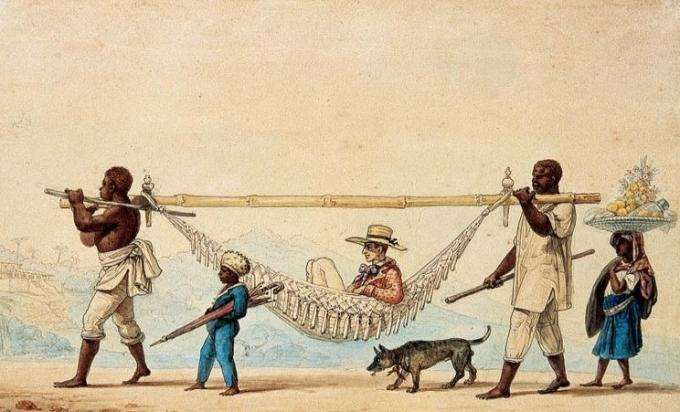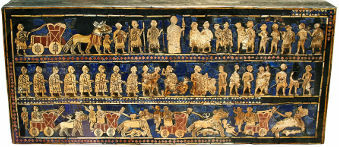The Brazilian people are the result of a process called miscegenation, that is, the mix of various ethnicities. For this reason, the Brazilian population is classified as multiracial.
The history of the composition of Brazil's population can be told by the process of formation of the country, especially from the arrival of Portuguese navigators to the territory, which would later be called Brazil, in the year of 1500.
How was the Brazilian people formed?
The formation of this mixed population happened through several processes throughout history. Many people were part of the formation process of the Brazilian people: indigenous, African, European and Asian.
This happened mainly because of the different nationalities that arrived in the country, for two main reasons: due to the colonization and immigration processes. Upon arriving here, they joined the original peoples who inhabited the region: the indigenous people.
The indigenous presence
Indigenous peoples are the original inhabitants of Brazil, when the territory did not yet have that name. There were numerous indigenous ethnic groups that lived in the region and occupied different spaces in the territory.
At that time, they lived in large communities, called tribes, and their livelihood was based on the use of what was provided by nature: hunting, fishing and gathering food.
It is estimated that about 3 millions of indigenous people inhabited the region at the time of the arrival of the Portuguese. According to FUNAI (National Indigenous Foundation), only 150 later, in 1650, the indigenous population had already been reduced to around 700,000 people.
Currently, according to the IBGE (Brazilian Institute of Geography and Statistics), the indigenous population is approximately 800 thousand people.
Learn more about Indigenous Culture.
the Portuguese colonizers
The first event that marks the beginning of the mixing of the Brazilian people is the arrival of Portuguese settlers in the Brazilian region, dated April 1500.
Upon arrival, the Portuguese came across the large indigenous population that already lived in Brazilian lands.
The arrival of the Portuguese was not a peaceful process for the region and for the inhabitants who already lived in the territory, since the colonizers were interested in the diversity of natural resources found in the lands. Brazilian companies.
 The board Disembarkation of Pedro Álvares Cabral in Porto Seguro in 1500 represents the arrival of the Portuguese to Brazilian territory (Oscar Pereira da Silva/1900).
The board Disembarkation of Pedro Álvares Cabral in Porto Seguro in 1500 represents the arrival of the Portuguese to Brazilian territory (Oscar Pereira da Silva/1900).
It was from this event that the first miscegenations took place, with the birth of new generations made up of children of Brazilian indigenous people and Portuguese colonizers.
The arrival of Africans
The people from the African continent arrived in the country through a process of enslavement, starting in the 16th century.
Africans were removed from their countries, enslaved and brought to the territory of Brazil by the Europeans, to work mainly in the coffee and sugar cane plantations that started to be cultivated. Many slaves were also forced to work extracting gold mines.
In addition to being forced into these rigid physical labors, enslaved Africans also served the aristocratic families that dominated the economic power of the time.
Added to the enslavement process was the commercialization of African slaves, considered by the Portuguese as a lucrative business.
African peoples were enslaved after unsuccessful attempts to enslave the country's native peoples, who - as much as they could - resisted Portuguese attempts at forced labor. However, it is important to know that in the initial period of colonization the indigenous people also carried out numerous forced labor.
Slavery was only abolished in the country in 1888, through the signing of the Golden Law.
See more details about the Cultural Diversity in Brazil.
 The work Return of an owner portrays slavery in Brazil (Jean-Baptiste Debret/1816).
The work Return of an owner portrays slavery in Brazil (Jean-Baptiste Debret/1816).
Although his arrival in the country was due to the violent process of slavery, the habits brought by the peoples Africans are one of the strongest influences of the country's culture, being fundamental in the process of formation of the population.
These are African heritages that are part of Brazilian culture: religions such as Candomblé and the cult of Orixás, music and the habit of consuming foods such as beans and cassava.
See more about Afro-Brazilian culture.
European immigration beyond the Portuguese
Some time later, the process of European immigration began to take place, starting approximately in 1850, after the official prohibition of the slave trade in the country.
From that moment onwards, European immigrants of different nationalities began to arrive in the country, who are also part of the formation of the Brazilian people.
In addition to the Portuguese, they arrived in Brazil: italians, germans and spanish. To a lesser extent, they also immigrated to the country, Russians, English, Swiss, Hungarians and Poles, between others.
The arrival of these immigrants was strengthened by the occurrence of wars on the European continent and the majority of these immigrants began to work in agriculture on large farms, mainly those producing coffee.
These immigrants formed colonies in the country, their habits and customs were also part of the formation of Brazilian culture and society.
See also the meanings of migration and immigrant.
Japanese immigration
Japanese immigrants are also part of the process of formation of the Brazilian population.
The first immigrants arrived in the country in the beginning of the 20th century and settled in São Paulo and Paraná. Both states have the largest Japanese colonies today.
The arrival of these immigrants happened especially due to the need to increase the number of people willing to work on the plantations of these two states. The process took place from an agreement to open immigration signed between the governments of Brazil and Japan.
It is estimated that currently 1.5 million Japanese descendants live in the country.
To learn more about the subject, see also the meanings of miscegenation, cultural identity and cultural diversity.

